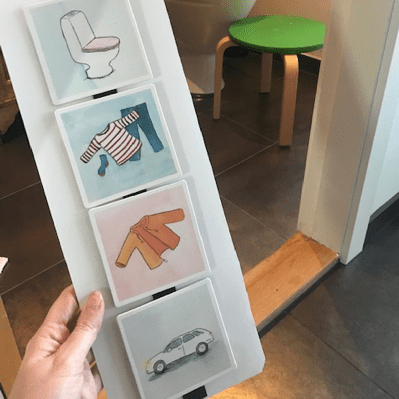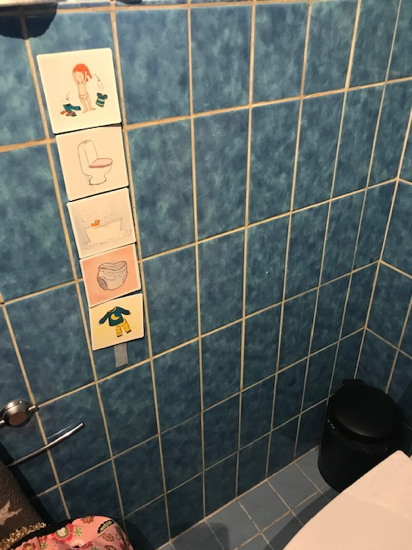We often find ourselves responding to our children with: “You can play for a little while”, “Give me 5 minutes” or “Not until this evening.” But we forget that kids don’t always understand these terms, leaving us with an angry or crying 2-year-old in the hallway.
Without any tools to do it differently, we often repeat these miscommunications over and over again. When we assume that children have the same conceptual understanding and sense of time as adults, communication fails and we end up banging our head against the wall. That’s why it makes SO much sense to me to give children a visual overview in small sequences, in the form of pictures and not just words. We owe it to our children to communicate on a par with their development.
”Cartoons ‒ not until this evening.”
It’s 3 pm and Milo (2.9 years old) has just been picked up from daycare.
“We have to remember to say ‘have a nice weekend’ to Dorothy. It’s Friday, that means it’s the weekend.”
“Yay! That means cartoons!”.
“Yes, we’ll watch cartoons after dinner.”
When we get home from the daycare, Milo runs to the sofa, cheering:
“Time for sweets and cartoons!”
“Hold on, I told you, not until we’ve had dinner.”
Milo gets upset and starts to cry.
”NO, NOW! It’s hard to wait. We can just have dinner now?”
This is a classic example of a situation where I completely forgot that Milo doesn’t quite have a sense of time or when we’ll actually be eating dinner, nor what he should do in the meantime. In Milo’s head, only sweets and cartoons exist. I thought we both understood we would be watching cartoons in the evening. That was my mistake ‒ of course I can’texpect him to understand that information.
So, I grab the pictograms and lay them out on the table in order. Even though there are no set times, Milo gets a sense of what time which activities will be happening. When Milo asks, “is it time for cartoons now?” I can refer to the pictograms and answer: “We’re playing at the moment, then we’ll eat and then it’s bathtime.”

The next Friday I prepared a board using cardboard, and this time our cosy Friday was much calmer. And the following Friday, Milo remembered that cartoons come after dinner and his Friday bath. Some parents worry that their children will become dependent on visualisation, but this certainly isn’t my experience. It’s helpful during periods when something is different (e.g. holidays) or something is extra difficult (change of daycare, etc.)
The pictograms are attached using the velcro and tape on the back, making the plate portable and easy to change, that’s how I think it works best.
“What do I do now?”
If your child, like mine, only seems to hear: “WE’RE GOING ON A TRIP” when you ask them to do a number of thingsbeforehand, I think that’s normal. I have therefore tried to create a little overview in these situations. I point and take the pictures down when they’re taken care of. It works really well, and I don’t get to the point where I’m desperately repeating, “I’ve told you plenty of times already.”
If Milo asks again and again, “What are we doing now?”, I know he’s missed something in the communication process. I grab a few pictograms and we talk through what we’re doing.
The pictures don’t have to be very specific for Milo, as he can remember that the snowsuit picture means we’re going for a walk. Which way works best is completely individual for both children and adults. For us, it’s situational and determined by each day. A tired boy can’t cope with a lot, and he needs me to create more of an overview. This is also good in periods with a lot of changes or unrest.
Visualisations that create routine
The evening and morning routine as well as the bathroom routine
I have described how we can help ourselves and our children to achieve better communication. But finally I would like to show you how we’ve used it in a fixed manner with a daily schedule.
Some parents get upset when the word structure comes up. My belief, however, is that everyone needs a certain amount of structure/routine to function. Children need help creating these routines.
Milo has become interested in going to the bathroom. In the beginning, it was only part of the “Evening Routine”. Sometimes there were baths on the schedule, other times not. But every day he looked at the pictograms, and we quickly made it a morning routine too.
After 3 weeks, he was suddenly big enough and no longer wanted to wear nappies during the day. Of course, this was partially to do with his age. But I am certain that by using the pictograms, Milo gained an understanding of the “sequence”, and that before doing anything, you have to go to the toilet. Besides the fact that he gained an understanding of this, it actually helped us as well. We’re habitual people who do as we’re used to doing and didn’t think to make him go to the toilet. In fact, he also started dressing and undressing completely automatically, because the pictogram said so!
Suddenly, we didn’t have to worry about: “You can’t catch me!” every time we asked him to get dressed!
Now we no longer use the pictograms for evening and morning routines, as they’re now part of Milo’s natural routine.
Read more about pictograms here
The post is written by: Nadja Gisselbæk Christensen – Educator at a special education school and mother of two. @hverdags_leg


Leave a Reply